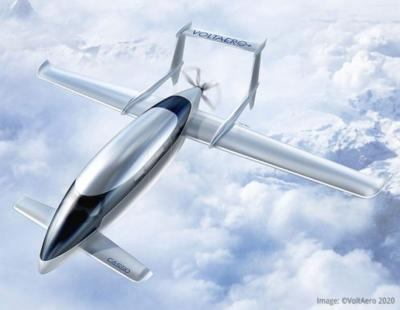Fri, Jul 30, 2021
Codes For Infrastructure To Support The eVTOL Market Are Still In Development
By Rex Alexander
While the future may be all electric, it now may very well be Hybrid-Electric. At least according to CEO Jean Botti VoltAero’s CEO and Chief Technology Officer (pictured).

At this year’s EAA AirVenture, VoltAero introduced their four-seat Cassio 330 – the first Cassio version of the VoltAero’s hybrid-electric aircraft family to enter production. The company believes that their Cassio 330 can be strategically positioned at U.S. airport locations based on user demand. To facilitate this vision, VoltAero has teamed up with KinectAir, a software aviation company focused on regional air mobility, to help facilitate their fractional ownership strategy, which is now available in the U.S. This strategy incorporates the company’s OnDemand flight services to be driven by artificial intelligence while utilizing advanced smartphone applications.
While many in the industry are talking about burgeoning eVTOL (Vertical Takeoff and Landing) market the Cassio 330 is designed to operate in the eCTOL (Conventional Takeoff and Landing) arena. This will allow the aircraft to utilize traditional airport infrastructure that is currently in place today without the need for costly and time-consuming retrofitting. That fact is very important in that standards and codes for infrastructure to support the eVTOL market are still in development and at best a 2-4 years away.

“The Jetsons future of rooftop-to-rooftop travel we see in very promising projects like Joby and Beta is just a long way out. The Cassio brings an efficient and elegant clean-sheet design for an aircraft that can take off and land on the smaller, local airfields we are already operating from. And we expect to bring it to the fleet as early as 2024,” explained KinectAir Chief Executive Officer Jonathan Evans. “This marriage of hybrid electric propulsion in conventional take off and landing aircraft (eCTOL) is the emerging leader for greening regional air travel. We put these aircraft on a network, and we put the power to summon them in your hands, and that’s game changing.”
Building on their validation effort on its hybrid-electric powertrain through flight trials with the company’s Cassio 1 demonstrator aircraft, VoltAero is advancing the Cassio family design phase for the future. Production will begin with the four-seat Cassio 330, featuring a combined hybrid-electric power of 330 kilowatts. Initial Cassio 330 deliveries are targeted for the fourth quarter of 2023, to be followed by the Cassio 480 and the Cassio 600, utilizing hybrid electric propulsion rated at 480 and 600 kilowatts, respectively.
More News
Aero Linx: Transport Canada We are a federal institution, leading the Transport Canada portfolio and working with our partners. Transport Canada is responsible for transportation p>[...]
Gross Navigation Error (GNE) A lateral deviation from a cleared track, normally in excess of 25 Nautical Miles (NM). More stringent standards (for example, 10NM in some parts of th>[...]
From AirVenture 2017 (YouTube Edition): Flight-Proven Booster On Display At AirVenture… EAA AirVenture Oshkosh is known primarily as a celebration of experimental and amateu>[...]
Aircraft Parachute System (CAPS) Was Deployed About 293 Ft Above Ground Level, Which Was Too Low To Allow For Full Deployment Of The Parachute System Analysis: The day before the a>[...]
Also: 48th Annual Air Race Classic, Hot Air Balloon Fire, FAA v Banning 100LL, Complete Remote Pilot The news Piper PA-18 Super Cub owners have been waiting for has finally arrived>[...]
 ANN's Daily Aero-Linx (06.29.25)
ANN's Daily Aero-Linx (06.29.25) ANN's Daily Aero-Term (06.29.25): Gross Navigation Error (GNE)
ANN's Daily Aero-Term (06.29.25): Gross Navigation Error (GNE) Classic Aero-TV: Anticipating Futurespace - Blue Origin Visits Airventure 2017
Classic Aero-TV: Anticipating Futurespace - Blue Origin Visits Airventure 2017 NTSB Final Report: Cirrus SR22
NTSB Final Report: Cirrus SR22 Airborne Affordable Flyers 06.26.25: PA18 Upgrades, Delta Force, Rhinebeck
Airborne Affordable Flyers 06.26.25: PA18 Upgrades, Delta Force, Rhinebeck




